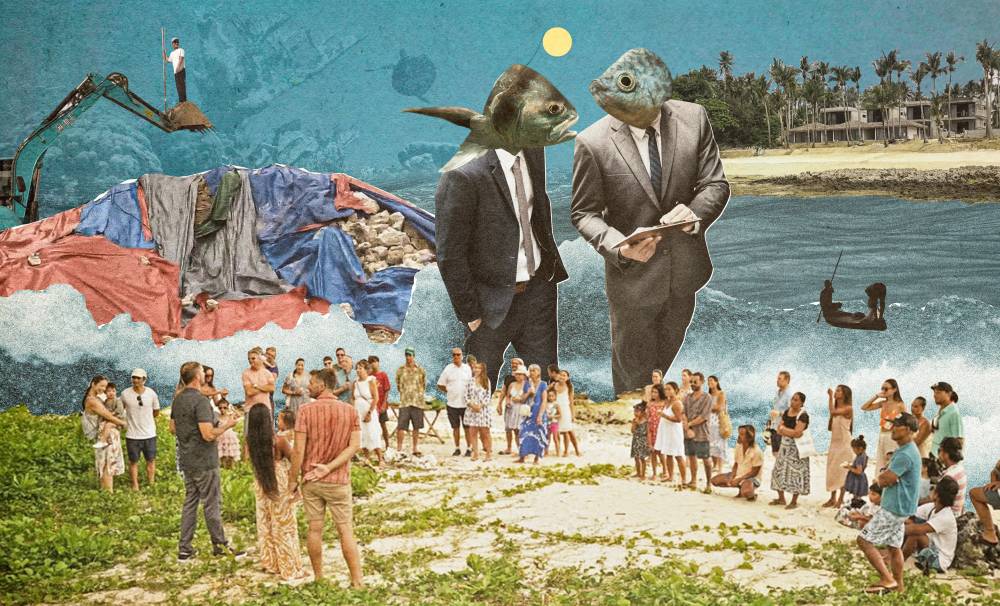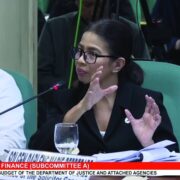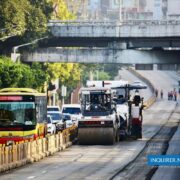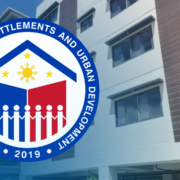‘Siargao is not for sale’

A luxury resort is catching major heat from locals and residents of Siargao Island after allegations that the developers illegally excavated parts of the protected reef in front of their villas.
The beachfront villas, registered under the name Paloma Resort, sit along a once-quiet cove facing Cloud 9—the world-famous surf spot that put Siargao Island on the map as the top surfing destination in the Philippines.
A cease-and-desist order was served to business owner Louie Matthew Nocum, who has become the target of online outrage over the destroyed reefs.
While Nocum’s social media accounts have been deactivated as of writing, his family members, who have been contacted, have yet to provide a statement. This is what is known so far.
Public reaction and dismay
The issue had been reported to local authorities at the beginning of September, but the news only gained widespread attention from the community when a string of posts by local pro surfer Ana Mae Alipayo went viral.
Online, the outrage and heartbreak from locals and residents alike over the destroyed reef are greatly felt. Anyone who has visited the island knows that Siargao’s beaches are naturally rocky, as it is particularly the reefs themselves that give the world-class waves their power and form. Locals worry that the resort’s destruction of the reef will affect the way the waves in Cloud 9 break.
More than vital habitats for marine life, these reefs serve a purpose. According to Dr. Michael Beck, lead marine scientist of The Nature Conservancy and a co-author of the study, “200 million people across more than 80 nations are at risk if coral reefs are not protected and restored,” coral reefs are the first line of defense against coastal erosion and storm surges. In fact, reefs can reduce wave energy by an average of 97 percent, according to studies done across all tropical oceans.
Without these reefs in place, the island becomes more vulnerable to environmental disasters, and more often than not, it is the local people who bear the brunt of these consequences.
Local pro surfer Ikit Agudo writes in her post, “When you damage our reef—everyone pays the price, especially those of us who have dedicated our lives to protecting it. We, the Lumads, are the ones who will suffer the most. In the worst case, you can leave—you have other homes, you can afford to live elsewhere. But we, the Lumads, have nowhere else to go. Siargao is our only home. Our lives and our future are here.”
A play-by-play of what happened
Jolan Saavedra, a well-respected community advocate, said that he met Nocum before construction began, and Saavedra had warned him that “the area he was about to build on was a sacred place for locals to gather with their families. And on top of that, a turtle sanctuary.”
Despite Nocum’s promises to respect the land, the local community first became aware of the reef’s destruction at the beginning of September, after a group of night fishermen saw backhoes working on the waterfront in the dead of night.
Saavedra accompanied the fishermen to the beach in the morning and confronted Nocum. Saavedra states, “I told him, ‘What did you do, what’s happening here? Do you not know basic environmental law?’” Nocum did not respond to this, and despite Saavedra saying he would raise the issue with authorities, the project still continued.
Cease and desist
After the surge of outcries online, a Cease and Desist Order (CDO) was swiftly issued by the Department of Environmental and Natural Resources-Protected Area Management Board (DENR-PAMB).
In a Facebook Live post last Sept. 20, congressman Bingo Matugas is seen serving the CDO to the foreman on site, with no sign of Nocum anywhere. In the video, Matugas passes by massive piles of broken coral covered by tarpaulin, stating he does not know if the corals are from Siargao or were illegally transported from another island. Matugas also notes that while Nocum had a building permit, he was not issued an ECC (Environmental Compliance Certificate) or PAMB Clearance, which are core requirements needed for a building permit.
Upon inspecting the site, LGU investigators also confirmed, according to their statement on Facebook, that “limestone rocks along the beachfront were manually destroyed with a hammer, as admitted by the caretaker, disturbing seagrass beds and removing a significant portion of natural rock formations, and not by an excavator as there were no physical traces of the latter present in the site.”
“A cemented structure was also found within the beach easement without the necessary clearance. These activities are clear violations of RA 11038 (Expanded NIPAS Act of 2018) and relevant local laws,” the statement continues.
Construction work on Paloma Resort has been indefinitely stopped by the CDO. However, on Sept. 22, a group of locals visited the beach for an inspection with an ecologist and the DENR. Despite the CDO in place, “there were still workers on site doing construction,” Agudo says.
Many are left wondering what will happen to Nocum and others possibly involved in the business. The entirety of Siargao Island is a protected area, by law, through the NIPAS Act, which means that any illegal excavation on the reef is not just environmentally disastrous—it is also punishable by law.
What it means to be a protected land
Siargao Island—known as the Siargao Islands Protected Landscape and Seascape (SIPLAS)—was declared a protected land on Oct. 10, 1996, through Presidential Proclamation No. 902. It is governed by the National Integrated Protected Areas System (Republic Act 7586), also known as the NIPAS Act, which provides the legal framework for protecting the biodiversity there.
Under the NIPAS Act, projects must first secure certification and permits from the Protected Area Management Board (PAMB), DENR, and relevant local government units (LGUs). This includes the Environmental Compliance Certificate (ECC) from the Philippine Environmental Impact Statement (EIS) System and the Water and Coastal Resource Permits, issued by DENR and Bureau of Fisheries and Aquatic Resources (BFAR).
Section 20 of the NIPAS Act explicitly prohibits “hunting, destroying, disturbing, or mere possession of any plants or animals or products derived therefrom without a permit from the Management Board,” which covers the aforementioned reefs, which were allegedly destroyed.
Moreover, Section 21 stipulates that those found guilty of violating the rules are subject to a fine, ranging anywhere from P5,000 to P500,000, and/or imprisonment for one to six years. And that isn’t including the value of what was damaged. What’s more, if the “area requires rehabilitation or restoration as determined by the court, the offender shall be required to restore or compensate for the restoration to the damages,” and the offender can be evicted from the land, with all materials collected, equipment, and devices forfeited in favor of the government.
And if the offender is an association or corporation, the law states that “the president or manager shall be directly responsible for the act of his employees and laborers.”
Not for careless exploitation
The official statement from the LGU dated Sept. 20 says that a caretaker on the lot admitted to destroying the reef with “only” a hammer, despite multiple eyewitness accounts claiming to have seen backhoes on the site.
Local pro surfer and president of Siargao Island Surfers Association (SISA), Nildie Blancada shares, “I saw everything. I saw the backhoe working right by the water. There were at least 20 workers that night, and I did talk to one of the staff to stop, because they [had] already destroyed half of the big rock. They did stop, but after an hour, they went back to destroying more again.”
To this, Saavedra comments, “If you can step on the spot [where the reef was destroyed], and also see the old pictures [of the reef], there’s no way they could have finished it in one month if they were only to use a manual hammer. It’s a big slab, like more or less around 50 meters. Aside from the rocks they removed from the shore, there is a massive limestone slab that they also removed.”
Siargao locals share that the cove has also been a popular picnic spot for decades, up until the villas began being built. Blancada mourns, “This is the place where my family would get together almost every weekend. This breaks my heart to pieces.”
The construction site first caught an initial wave of resistance last April 2024 for chopping down multiple coconut trees and blocking access to the public beach. However, while coconut trees will grow back into full maturity after 15 years, locals lament that broken reefs will take years to recover. Antonio Claparols, president of the Ecological Society of the Philippines, states that in three to five years, coral reefs will only grow one inch.
Local pro-surfer Aping Agudo writes, “This reef is home to marine life, it shelters nesting turtles, and it helps shape the waves that make Cloud 9—just around the corner. Years of natural balance were disrupted for the sake of convenience and profit.”
Agudo warns, “Siargao is not for careless exploitation. Developers who come here must respect the environment and the people who call this island home. Short-term gain cannot come at the cost of long-term destruction. The ocean is our life. The reef is our protection. And Siargao is not for sale.”
On Oct. 4, the DENR-PAMB officially passed a resolution to file a case against Nocum and Paloma Resort. Previously, they had requested that the LGU revoke Paloma Resort’s building permit in light of the CDO and all of the resort’s environmental violations. There has not yet been word from the LGU whether or not they will officially revoke Paloma Resort’s building permit.





















